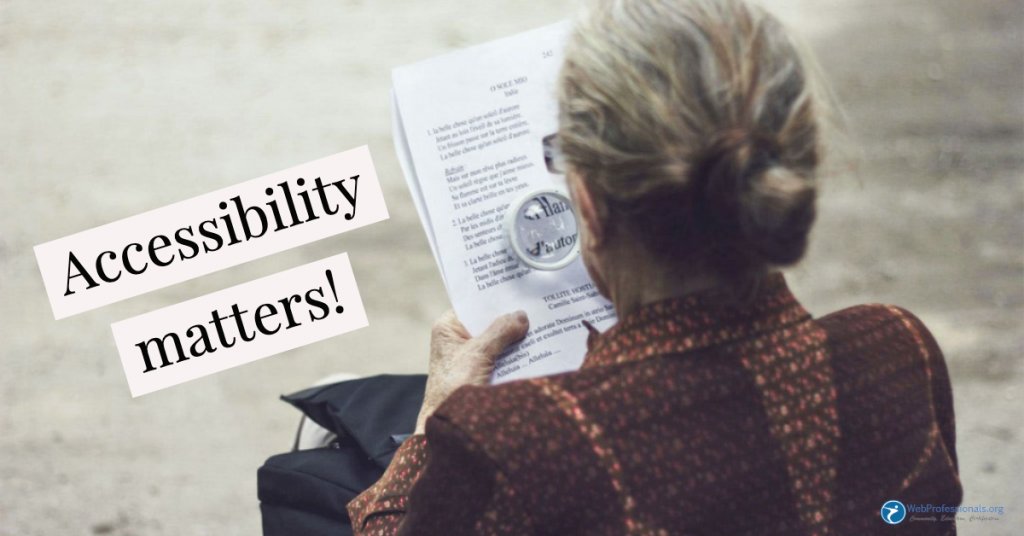
5 Things to Consider Regarding Web Accessibility

Is Your Website Section 508 Compliant?
Imagine this… You manage a website for a company. Someone from Legal approaches you with a question, “Is the company’s website Section 508 compliant”? How would you respond?
Your first reaction might be to cringe. Or, maybe you get that “deer in the headlight” look because honestly, you haven’t dealt a lot with web accessibility. You wonder, “What is that anyway?”
Web accessibility can be a scary thing, especially if you don’t have much experience with it. But fear not! There is good news!
Here are five things to consider when establishing an accessible, and ultimately optimized, web experience for all.
1. There is no such thing as a completely 100% accessible website.
It might be of some comfort to know that it is pretty much impossible to create a web experience that is completely 100% accessible by all. Most websites are not built with web accessibility in mind, so know that you will be retroactively fixing problems.
Also know you will run across a variety of issues. Some issues you will be able to fix easily, while others will be much more challenging. You may even come across issues that you won’t be able to fix at all. Understand that applying accessibility to an established website can be like uprooting a well-established tree. It can be done, but it’s going to take a lot of effort.
2. Web accessibility is not a binary thing.
You can’t just answer the question with a “yes” or “no” response. It is not just one or the other. Web accessibility will always have some shades of grey. The site you manage will probably have some accessible features already, like alt descriptions for images, and heading tag <h1 – h6> tags.
The website you manage is probably already somewhat accessible. The question is, “what shade of grey is it?” Remember there is no such thing as a 100% accessible website.
3. WCAG and Section 508 standards are similar but different.
If you do your research, you’re going to run across something called WCAG and Section 508. It’s important to know that these things are similar, but different.
The Web Content Accessibility Guidelines (WCAG) is advice developed by the World Wide Web Consortium (W3C), with the goal of establishing standard practices regarding web content. These standards are aimed at teaching individuals and organizations how to develop web content for all people, including those with physical and mental disabilities.
Section 508 also deals with creating accessible web content, but it is different than WCAG. WCAG is a cooperative web standard. Section is a law that requires government agencies to make their websites, and other technology, accessible to people with disabilities. If you manage a website that uses government money like a university or health insurance website, you might have to abide by Section 508.
4. What is the ultimate goal of web accessibility?
Is the ultimate goal of web accessibility just to be compliant? I would say no. Approaching web accessibility with the ultimate goal of compliance in mind is short sighted.
The ultimate goal of web accessibility is to create a web “experience” that is accessible by as many people as possible, regardless of ability. This issue is really about humans and their ability to access the information that they need. Yes, the law is involved in some instances, but ultimately we are talking about being compassionate towards others, and good stewards of the information that we manage.
5. If you must have benchmarks and metrics, create a checklist.
Now the person from Legal is probably looking for some sort of concrete evidence that they can use to defend the company. Here is one way to approach this:
- What is the law, and what does it state that the website must have?
- Think about the senses you have as a human being (sight, touch, and sound etc.), which ones do you use to take in information?
- How will you modify the website based on someone who is visually impaired, doesn’t hear well, or doesn’t have use of their hands?
- Don’t “forget” about memory retention! What types of modifications will you make for people who have a cognitive impairment?
- Write these things down and create a list. Do an audit of the site. What do can you do differently?
- Think about your website and the content in terms of numbers. Maybe you have 20 PDFs and none of them are accessible. Can you create a metric around this? Can you strive for all 20 PDFs to be accessible by the end of the year?
- Take this information to Legal and work with them.
So, going back to the original question? Is your website Section 508 compliant? How would you respond?
Understand that Legal is probably going to want to resolve this issue in a concrete way. Their job is to protect the company from legal trouble; however they don’t necessarily understand websites and web content. Your job is not to understand the law entirely, but to understand how the web works.
Remember you are the web expert. Respond appropriately and move forward in a collaborative and productive manner. Together you can create a wonderfully optimized web experience for as many people as possible, while keeping the company out of legal trouble.
